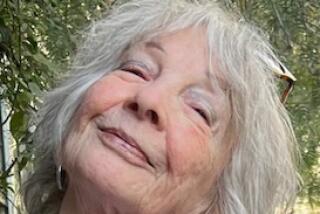Nothing Fails Like Success : IRWIN SHAW: A Biography <i> by Michael Shnayerson (G. P. Putnam’s Sons: $21.95; 441 pp., illustrated; 0-399-13443-3) </i>
- Share via
Perhaps the tragedy of Irwin Shaw was that he eluded categorization. He was a burly lumberjack of a man with woolen curls and a broken beak of a nose, but his best prose had a delicacy and plaintive rue that belied his displays of machismo. He flirted with the left during the savage political wars of the ‘30s and ‘40s, winning praise as a voice of proletarian malaise, but the ‘50s revealed him as nondoctrinaire and essentially apolitical. He made his reputation with an avant-garde anti-war play and solidified it with a stunning series of stories in The New Yorker, but he would soon be regarded and then dismissed as a popular writer, not a literary one. Shaw himself, speaking of writing but also providing a defense of his life, once said it gave him “the private and exquisite reward of escaping from the laws of consistency.”
Maybe so, but the Irwin Shaw who emerges in Michael Shnayerson’s thorough, shrewd and compelling biography would always be plagued by his own resistance to those laws. Born in Brooklyn in 1913 of a middle-class Jewish family that would be wrecked by the Depression, Shaw (nee Shamforoff) attended Brooklyn College, then landed a job cranking out radio scripts like the protagonist of his famous story, “Main Currents in American Thought.” At 22, he wrote his anti-war agitprop drama, “Bury the Dead,” and immediately captured the attention of New York’s intelligentsia who hailed him as a second Clifford Odets. The next year he would make his first appearance in The New Yorker. He also would be lured to Hollywood to write screenplays. The die was cast.
Shaw’s stories were praised and anthologized, and his first novel, “The Young Lions,” a saga of three soldiers enduring the war, caused a sensation. But as he shuttled easily between New York and Hollywood, between the literary world and what the literati disparaged as the world of commerce, Shaw paid dearly for his success. His reputation suffered. The literati began attacking him. Leslie Fielder in a typical broadside called his work “half-art.” Others regarded him as a hack--a literary whore. In any case, as Shnayerson demonstrates, Shaw became to some a symbol of the corruption of a serious writer, to others a symbol of the deterioration of public taste. It wasn’t just that he was no longer a literary writer. It was that he was a turncoat, sacrificing his art for the almighty dollar--an awful sin in New York intellectual circles.
Shaw tried hanging on to his literary reputation, but it was impossible. Partly he was the victim of jealousy, partly of revenge for his not playing by the rules and not living the austere literary life. (Norman Mailer’s analysis of why the literary establishment reviled Shaw: “Because he’s very rich, he likes martinis--and he’s Jewish.”) Partly, however, it was because Shaw’s style wasn’t high literary. With the exception of a few late potboilers he batted out, it wasn’t pulp melodrama either. Sadly for him, Shaw existed in a limbo where there are no proponents--too good to get lumped with mercenaries like Sidney Sheldon, not good enough to be elevated into the pantheon.
With sensitivity to both the irony and pathos of Shaw’s predicament, Shnayerson deploys the tension between lucre and literature as the theme of his book, and he is brilliant at detailing the shape and meaning of Shaw’s life as well as his victimization by literary politics. But this is also a critical biography, one which intends to establish Shaw’s rank as something more than a master storyteller, a backhanded accolade Shaw often received in his later years. If there is a deficiency to “Irwin Shaw,” it may be Shnayerson’s inability finally, despite a close and canny examination of Shaw’s work, to substantiate the writer’s claim on greatness. Shaw’s voice was unmistakable: fleet, fluid, youthful even when the subject was jadedness, simultaneously wistful and wry. (Unfortunately, possibly for legal reasons, very little of Shaw’s prose appears in the book.) He had craft. What he lacked was a governing sensibility, a comprehensive and complex vision of the world, the tenacity of mind and spirit to galvanize each work with his desperation. William Styron, a friend, called it pain: “There’s not enough true pain in his work.”
In his life Shaw had pain in abundance. Married for 30 years to a peevish and jealous woman (for good reason, one should quickly add) with whom he had virtually nothing in common, fretting over his finances despite his extraordinary wealth, suffering badly the decline of his status and realizing he couldn’t appease the gods of criticism, condescended to by the new generation of serious writers, Shaw nevertheless refused to play the role of anguished artist. Instead he became, in Shnayerson’s word, a figure .
Abandoning the United States, largely for tax reasons, and settling in a Swiss ski village named Klosters, Shaw conducted an endless bacchanal of convivial drinking, affairs, parties, tennis matches and ski runs, joined by dozens of illuminati who couldn’t resist his company. His life did corrupt his writing; he was now turning out “Rich Man, Poor Man,” “Beggarman, Thief” nd “Evening in Byzantium” where once he had produced “The Girls in Their Summer Dresses” and “The Eighty-Yard Run.” But as Shnayerson reasons it, Shaw had chosen to make “a veritable artwork of his life.” The writing now seemed to come second.
As Shaw’s life sputters to its conclusion, his biography inescapably does too. In the end, Shaw devolved into an aching hulk, disabled by arthritis and debilitated by drink, though with “Rich Man, Poor Man” he was to become commercially more successful than ever. The games had worn thin. So had the womanizing. He finally divorced his wife only to remarry her years later when he was felled by illness and needed companionship. When he died in 1984 at age 70, his friends and family decided to scatter half his ashes near Klosters as Shaw had instructed, but they also carried half home to the United States. It was a gesture perfectly in keeping with Shaw’s life. Even in death Shaw would be divided. Even in death, as this exacting and elegant biography makes plain, Shaw would labor to escape the awful laws of consistency.
More to Read
Sign up for our Book Club newsletter
Get the latest news, events and more from the Los Angeles Times Book Club, and help us get L.A. reading and talking.
You may occasionally receive promotional content from the Los Angeles Times.








